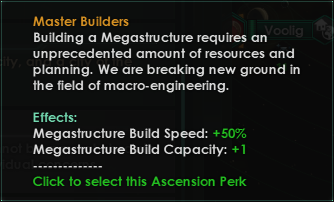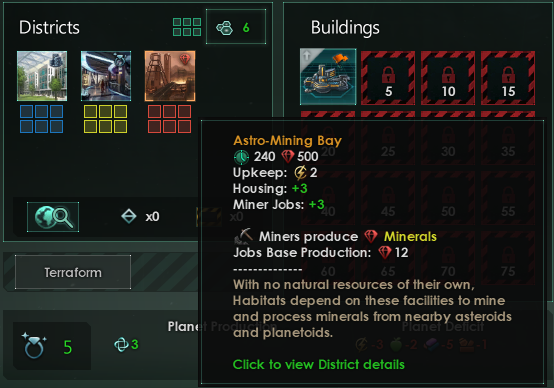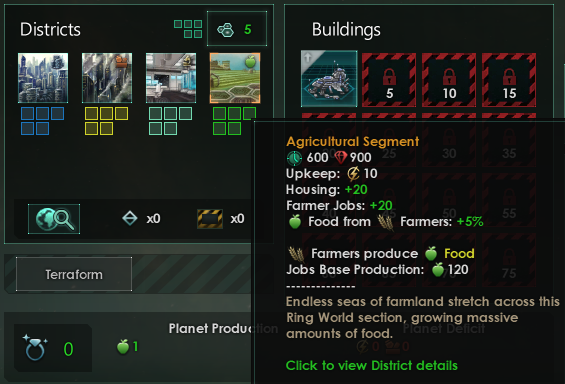Hello everyone!
First of all, I’d like to follow up on last week’s dev diary by sharing some more things we’re trying out with Megastructures (and habitats!).
After all of that, we also have something new to talk about!
Let’s start from the beginning – which of course leads us to the Mega-Engineering technology itself.
As always, numbers may not be final and temporary things may be sighted.
Mega-Engineering
Mega-Engineering is still a rare technology, but will now be more likely to appear as you build more Habitats and Citadels. This means it is way more likely to appear if you are performing actions in the game that would lead you towards the route of building larger and more powerful structures.
Master Builders
The Master Builders ascension perk no longer unlocks mega-engineering or adds size to habitats, but instead increases the number of megastructures you can simultaneously build by +1. What about increased habitat size you ask? Well, keep on reading!

Habitats & Voidborne
Habitats are no longer locked behind the Voidborne ascension perk but is rather a technology that branches off from the Star Fortress technology. Habitats now have a default of 80% habitability. We’re also experimenting with that some of the habitat’s districts will depend on which planet they are built over. In case you build one above a planet with mining deposits, this could happen:


Voidborne ascension perk now increases habitat size by +2 and increases Habitat habitability by 20%. This should mean it becomes more of a choice for specialization, rather than feeling it is a non-choice.
As a final note on habitats, it might be worthwhile to reiterate my thoughts that I eventually want to add different levels/sizes to habitats. It is however not something for the immediate future, but a little further down the road.
Ring Worlds
We didn’t quite like how Ring Worlds ended up feeling like a vast farm, so we’re making some changes. Instead of being a size 50 with regular districts, we’re changing it to a size 5 with a unique type of districts – segments. A Ring World, as you know, has 4 planets. Each planet can now build 5 segments, which are very powerful districts with many jobs and a lot of housing.

Minor Artifacts

Some of you might recognize the icon for what was supposed to become arcane technology, that partially got into 2.2. It was something that I was personally working on, but that didn’t work out as I had imagined it, and that I didn’t get enough time to finish with other things taking priority.
In the next upcoming DLC, you will be able to come across Minor Artifacts. “Minor Artifacts” is a broad term that includes any smaller and nameless artifact left behind by ancient civilizations. They are never gained passively every month, but will rather have to be found.
What are they used for, I imagine you asking? Well, the basic functionality is that they can be consumed in so-called artifact actions. There are a bunch of different actions that can be performed by consuming Minor Artifacts, with varying effects for each.
Some of these actions will be locked behind a technology, which some may also recognize.

Arcane Deciphering allows you to consume Minor Artifacts for a random technology-related bonus.

------------
That’s it for this week! Happy Easter everyone! Next week we’ll be back again
P.S. Attaching an Easter present


First of all, I’d like to follow up on last week’s dev diary by sharing some more things we’re trying out with Megastructures (and habitats!).
After all of that, we also have something new to talk about!
Let’s start from the beginning – which of course leads us to the Mega-Engineering technology itself.
As always, numbers may not be final and temporary things may be sighted.
Mega-Engineering
Mega-Engineering is still a rare technology, but will now be more likely to appear as you build more Habitats and Citadels. This means it is way more likely to appear if you are performing actions in the game that would lead you towards the route of building larger and more powerful structures.
Master Builders
The Master Builders ascension perk no longer unlocks mega-engineering or adds size to habitats, but instead increases the number of megastructures you can simultaneously build by +1. What about increased habitat size you ask? Well, keep on reading!

Habitats & Voidborne
Habitats are no longer locked behind the Voidborne ascension perk but is rather a technology that branches off from the Star Fortress technology. Habitats now have a default of 80% habitability. We’re also experimenting with that some of the habitat’s districts will depend on which planet they are built over. In case you build one above a planet with mining deposits, this could happen:


Voidborne ascension perk now increases habitat size by +2 and increases Habitat habitability by 20%. This should mean it becomes more of a choice for specialization, rather than feeling it is a non-choice.
As a final note on habitats, it might be worthwhile to reiterate my thoughts that I eventually want to add different levels/sizes to habitats. It is however not something for the immediate future, but a little further down the road.
Ring Worlds
We didn’t quite like how Ring Worlds ended up feeling like a vast farm, so we’re making some changes. Instead of being a size 50 with regular districts, we’re changing it to a size 5 with a unique type of districts – segments. A Ring World, as you know, has 4 planets. Each planet can now build 5 segments, which are very powerful districts with many jobs and a lot of housing.

Minor Artifacts
Some of you might recognize the icon for what was supposed to become arcane technology, that partially got into 2.2. It was something that I was personally working on, but that didn’t work out as I had imagined it, and that I didn’t get enough time to finish with other things taking priority.
In the next upcoming DLC, you will be able to come across Minor Artifacts. “Minor Artifacts” is a broad term that includes any smaller and nameless artifact left behind by ancient civilizations. They are never gained passively every month, but will rather have to be found.
What are they used for, I imagine you asking? Well, the basic functionality is that they can be consumed in so-called artifact actions. There are a bunch of different actions that can be performed by consuming Minor Artifacts, with varying effects for each.
Some of these actions will be locked behind a technology, which some may also recognize.

Arcane Deciphering allows you to consume Minor Artifacts for a random technology-related bonus.

------------
That’s it for this week! Happy Easter everyone! Next week we’ll be back again
P.S. Attaching an Easter present



